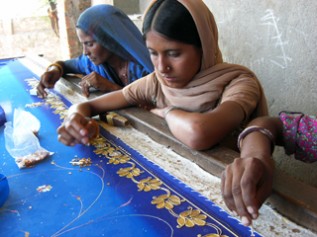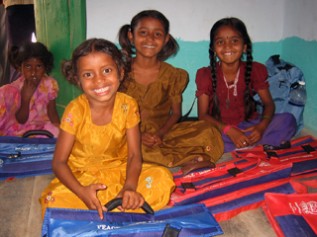Field Program for Children in India and Ghana
Three strategies
1. Focusing on agriculture and rural areas, especially cacao bean and cotton seed production
60% of all child labourers in the world are engaged in agricultural sector. Some industry-wise initiatives to solve child labor issues have already well succeeded in the world.
2. Listening to children’s voice and reflecting them to the improvement of school and local community
It is children themselves who understand their needs. We listen carefully to their voices and reflect their voices to the community and social development.
3. Helping community people’s self-independence making sustainable system in corporation with local government
Establishing the environment which provides all children with quality education and supporting community people to be independent economically utilizing the government system.
ACE111 (ACE Triple One): Three goals by 2012
- Rescuing 1 thousand children from child labor and helping 10 thousand children to receive education.
- Let 1 million people knowing the truth of child labor.
- Increasing supporters up to 10 thousand people.
SMILE-Ghana Project
Sustainable Management of cocoa farm and Improved Life via Education for the elimination of child labor
Background
 The cocoa bean, which is the raw material for chocolate, is mainly produced in western Africa. As much as 70% of cocoa that Japan is importing is from Ghana today. In Ghana, through the process of producing cocoa, a lot of children are forced to work under dangerous condition, such as using sharp hatchets or carrying heavy stuff. Those children are not allowed to go to school. One reason is that most cocoa farms are such a small scale that farmers cannot make their own living only by producing cacao bean nor afford to send children to school. Another reason is that educational system in Ghana itself is extremely weak. More severely, children who are victims of human trafficking were found in poorer area in northern Ghana.
The cocoa bean, which is the raw material for chocolate, is mainly produced in western Africa. As much as 70% of cocoa that Japan is importing is from Ghana today. In Ghana, through the process of producing cocoa, a lot of children are forced to work under dangerous condition, such as using sharp hatchets or carrying heavy stuff. Those children are not allowed to go to school. One reason is that most cocoa farms are such a small scale that farmers cannot make their own living only by producing cacao bean nor afford to send children to school. Another reason is that educational system in Ghana itself is extremely weak. More severely, children who are victims of human trafficking were found in poorer area in northern Ghana.
After conducting field survey in 2008, ACE launched “SMILE-Ghana Project” to protect children from child labor and support their education in partnership with local NGO “Child Research for Action and Development Agency(CRADA).
Main activities
- Monitoring whether child labor exists or not, checking school attendance and persuading their parents to send their children to school,if necessary.
- Improving school environment in corporation with the school management committee, PTA, village leaders and local governments.
- Establishing child committee where children can discuss themselves about their own problems and convey their opinions to adults.
- Improving children’s health through conducting health check up and holding workshop for Community people to learn hygiene, nutrition and health.
- Providing cocoa farmers with the training of agricultural techniques to enhance productivity and earnings.
Achievements(as of 2010)
- The committee members who are in charged of monitoring child labor go on patrol regularly and persuade parents to send their children to school. As a result, 98 children were withdrawn from labor and enrolled in school.
- 2 children who were victims of child trafficking and forced to work were rescued. They are now back to their family and go to school.
- The secondary education was introduced in school in cooperation with Local Secretariat of Education. At present, about 300 children in the village go to school from kindergarten to secondary school.
- Parents in the village are more aware of child education, and more children are provided with school uniforms and stationary. Then, children are motivated to learn in school increasingly.
- 40 cacao farmers received training on cacao production to learn new knowledge and agricultural techniques.
Children’s voices
Evans (6th grade, second son of a cocoa farmer)
 “Since my father looked troubled in making our living, I felt that it was better to start working. That is why I missed school and working in cocoa farm” he says.
“Since my father looked troubled in making our living, I felt that it was better to start working. That is why I missed school and working in cocoa farm” he says.
He often worked in cacao farm instead of going to school and he did not have his school uniform or stationary. Now, he goes to school everyday wearing uniform, and his dream is to be a soccer player.
His father Simon says that now I got to know the importance of letting children receive education, so I started to save money for them.
Child Friendly Village Project
Background
 India is one of the countries that child labor is spread dramatically. It is said that the number of children who are forced to engage in labor is from 60 million to more than 100 million and 7.2 million among never-enrolled children. Especially in rural areas because of agricultural work, housework and stock-farming work, many children are not allowed to go to school continuously.
India is one of the countries that child labor is spread dramatically. It is said that the number of children who are forced to engage in labor is from 60 million to more than 100 million and 7.2 million among never-enrolled children. Especially in rural areas because of agricultural work, housework and stock-farming work, many children are not allowed to go to school continuously.
In addition, school environment is also poor due to the lack of teachers, classrooms and bathrooms. In many regions, administrative system to improve educational environment has not been well established.
ACE started to support “Child Friendly Village Project” together with local NGO “Bachpan Bachao Andolan (BBA) form 2003.
Main activities
- Organizing meetings and campaigns to raise awareness about education among parents and community people so that all children in the village will be able to go to school.
- Forming elected child assembly where children can discuss themselves about the issues around their daily life and reflecting their opinion to improve school environment.
- Forming women’s group and youth group and trying to enhance earnings among poorer families through vocational training opportunities and employment scheme.
- Tackling various issues in the village such as education, maternal and child health etc, through discussion among the community people or appealing to local governments.
Achievements(as of 2010)
- In total 475 children were withdrawn from labor, and 5,576 children to go to school regularly in 12 different villages so far since the projects were implemented.
- Elected Child Assembly was formed and children started to discuss on problems faced by them in school and village. Children also work together with village governing body to solve the problems.
- Women’s groups were formed in the village. The mothers, the group members, received vocational training to get job and also started savings to manage the family budget.
- Parents in the village are more aware of child education, and more children are provided with school uniforms and stationary. Then, children are motivated to learn in school increasingly.
- Villagers are more aware of and started to utilize various government schemes. For example, economically poor families are now supported to improve family income through employment and social security schemes.
Parent’s Voices
Anita (fictitious name, mother)
“Since I started to work and earn money, now I can afford to buy stationary for my children and they can go to school everyday. I cannot write and read at all because I didn’t have chance to go school when I was young. I sometimes visit school and see whether my children are studying hard.”
Children’s voices
Puja (fictitious name, 11 years old)
 She used to work to help housework and agricultural work about 10 hours a day in order to help family and earn money instead of my mother being sick. But now, she goes to school everyday and her family has received government support in the social welfare scheme.
She used to work to help housework and agricultural work about 10 hours a day in order to help family and earn money instead of my mother being sick. But now, she goes to school everyday and her family has received government support in the social welfare scheme.
She says,”I’m so happy to go school just like other children do.”
PEACE-India Project
Promoting community Engagement for Assisting Change from child labor to Education in cottonseed production area in India
Background
 Cotton is the basic raw material for the clothes and towels we usually use daily. India has the largest area of cotton cultivation in the world. Where it is produced, thousands of children are forced to work pollinating flowers and picking cotton. According a report by the Global March Against Child Labour, in 2009-2010, approximately 381,500 children were employed in the cottonseed farms in India.
Cotton is the basic raw material for the clothes and towels we usually use daily. India has the largest area of cotton cultivation in the world. Where it is produced, thousands of children are forced to work pollinating flowers and picking cotton. According a report by the Global March Against Child Labour, in 2009-2010, approximately 381,500 children were employed in the cottonseed farms in India.
The field survey conducted by ACE in 2007-2009 found that many girls were working without receiving primary education especially in hybrid cottonseed farms in the Andhra Pradesh state of India. During fertilization and harvesting seasons, they worked long hours and suffered from various health issues due to chemical pesticides and the physical nature of their work.
Outline of ACE’s PEACE-India project
Eliminating child labour in cotton/cottonseed farms with community participation and empowerment
To protect children from hazardous labour and ensure that they are enrolled in school, ACE launched in 2010 the “PEACE-India Project” in partnership with a local Indian NGO, “Society for People’s Economic & Educational Development (SPEED).” Overall the project mobilizes local resources and communities, promotes children’s rights, and protects children from child labour in the cotton sector.
| Project name | PEACE-India Project (Promoting community Engagement for Assisting Change from child labour to Education in cottonseed production area in India) |
|---|---|
| Target area | Mahabubnagar District in Andhra Pradesh, India |
| Project period | approx. 4 years in one community |
| Expected Outcomes |
|
Main activities
- Raising awareness about child labor issue and the importance of education through organizing meetings and holding workshops for community people.
- Forming villager’s group where community people themselves monitor child labor and school attendance and rescue children from labor.
- Managing “Bridge School” where never-enrolled children are able to receive basic education and then will be mainstreamed into formal school in the village.
- Improving school environment by school teachers, parents, children and village leaders who regularly discuss about school issues and work in corporation with local governments.
- Forming children’s group and giving chances to children to participate in school improvement and solve problems they have, such as child marriage and bonded labour.
Achievements(as of 2011)
- Villagers’ group was formed in order to go on patrol to see child labor in the field and convince parents to send their children to school. As a result, 123 children were withdrawn from labor and started to receive basic education.
- A Bridge-School was established to provide non-formal education for never-enrolled or dropped-out children in the village. 100 children learned basic education in the Bridge-School, and out of them, 38 children are mainstreamed to formal school in the village.
- Villagers are more aware of importance of education, and more children are enrolled in school. Now, about 380 children regularly go to school.
- School teachers, parents, children and village leaders started to hold regular meeting to discuss school problems together. Also, school environment is getting improved such as establishing class rooms and supplementing teachers through their requests to the local government.
- Adolescent girls were formed into a group to solve problems which they face in the village such as early marriage and drop-out and dowry system. They share their problems and solutions and are also received vocational training to become more self-independent in their future.
Tackling Child Labour in the Cotton Sector in India
Target area: Nagardoodi village
Project period: April 2010 to March 2014
To achieve the following project outcomes, various activities are conducted through mobilizing local resources and promoting children’s rights in the community. As a result, the project has withdrawn 162 children from child labour and ensured all 530 school-aged children in the village regularly go to school.
To date:
- Through various awareness campaign and events, villagers are more aware of the importance of education. Villagers formed a “Child Rights Protection Forum (CRPF)” group to monitor child labour in the field and convince parents of child laborers to send their children to school.
- A Bridge-School was established to provide non-formal education for children who were never-enrolled or dropped-out of schools. As a result, 100 children received a basic education and are now mainstreamed into formal school.
- School teachers, parents, children and village leaders started to hold regular meeting to discuss school problems together.
- The school environment is improved through new classrooms and support to teachers in their requests to the local government.
- Adolescent girls received vocational training to become more independent. They formed a girls group “Kastruba Gandhi Balikala Sangam (KGBS)” to solve problems they face in the village such as child marriage, drop-out, and the dowry system.
- 80 parents of poor families received trainings in livestock agribusiness and Self-Help Group management for regular saving and micro-credit. They improved family incomes and now purchase their children’s leaning materials.
- Cotton farmers received training on Non Pesticide Management to improve their agricultural skills and income.
Children’s voices
Komar (fictitious name, older sister, 13 years old) and Lathika (fictitious name, younger sister, 12 years old)
 Two sisters started to work in cotton farm because their father has no job because of alcohol addiction and their mother works as a daily wage labor. She borrowed money from a cotton farm owner. They are doing artificial fertilization. Daily wage is 70 rupees (about 140 yen) and have to work even on weekend. They don’t have chance to go school while their 8-year-old brother goes to elementary school.
Two sisters started to work in cotton farm because their father has no job because of alcohol addiction and their mother works as a daily wage labor. She borrowed money from a cotton farm owner. They are doing artificial fertilization. Daily wage is 70 rupees (about 140 yen) and have to work even on weekend. They don’t have chance to go school while their 8-year-old brother goes to elementary school.
She says,”I don’t like working in the farm. I always feel sick having headache and stomachache because I breathe agricultural chemicals every day. I really want to go school rather than working there.”









